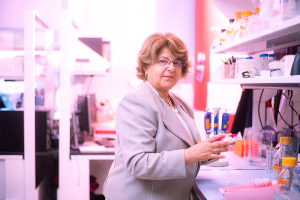NIH-funded project to explore whether gene therapy can correct genetic deafness
A world-renowned authority on genetic mutations associated with hereditary retinal disorders from the University of Houston is working with a researcher from Harvard Medical School specializing in the diseases and disorders of the ear, nose and throat (ENT) to advance research involving gene therapy options that could one day expand treatment of patients suffering from Usher syndrome.
Usher syndrome is a genetic disorder characterized by partial or total hearing loss and progressive vision loss. It affects fewer than 0.02% of people in the United States of America – between four and 17 per 100,000 – accounts for about half of all hereditary deaf-blindness cases, according to the National Institutes of Health (NIH). There are three types of Usher syndrome, and each type is associated with a single gene defect.
The NIH awarded a one-year, $354,000 grant for a project titled “Gene Therapy of Usher Syndrome” to Gwenaelle Gělěoc, a researcher with Boston’s Children’s Hospital and Harvard Medical School, and Muna Naash, John S. Dunn Endowed Professor with joint appointments at the UH Cullen College of Engineering and the UH College of Optometry. The UH share of the funding is $85,000.
“The funding is for us to establish preliminary data that we can base future research on,” said Naash. “In the long run, we want to develop gene therapy that can help Usher patients.”
The beginning
Naash, who has been working to eradicate eye diseases since the 1980s, is often invited to speak to scientists and patients. She became aware of patients with Usher syndrome during visits sponsored by the Foundation Fighting Blindness and the Usher Syndrome Coalition.
“Meeting them, hearing about their issues, really just broke my heart,” Naash said. “We are talking about children. They’re born with very low hearing and very low vision, and it progressively gets worse. It’s devastating.”
She decided to study one of the most common mutations in the genes involved. “The gene is very big and difficult to work with,” Naash said. “But we were able to design it in a smart way so that I can track where the protein responsible originates and whether it has any side effects when it’s mutated.”
The research project
The NIH-funded project focuses on the cochlea, the spiral cavity of the inner ear, which is surrounded by bone and difficult to reach. “I follow the science,” Naash said, explaining how she proceeded down this particular research path.
“We want to correct the disease by delivering the normal protein or gene to the hair cells in the cochlea so they have what they need to function properly,” she said.
Delivering anything into a cell is challenging, but reaching the hair cells and the spiral structure of the cochlea make it even more difficult. Naash and her research partners have learned how to do this in the eyes and she is hopeful that this new challenge will also be tackled successfully.
“Gělěoc is an expert in her field and I’m an expert in mine,” she said. “We’re going to take these challenges step by step and figure out how to overcome them one at a time and move forward to address the next challenge.”
Both Naash and Gělěoc are working with animal models, a crucial step to prove the concept – that the proposed gene therapy works correctly – before it can be applied to people with Usher syndrome.
“If we’re successful with this, then we use the information to do more research until we can correct the defect for the eye, the cochlea and other impacted organs at the same time,” Naash said. “The ultimate goal is to create a product that we can give doctors to help their patients.”
